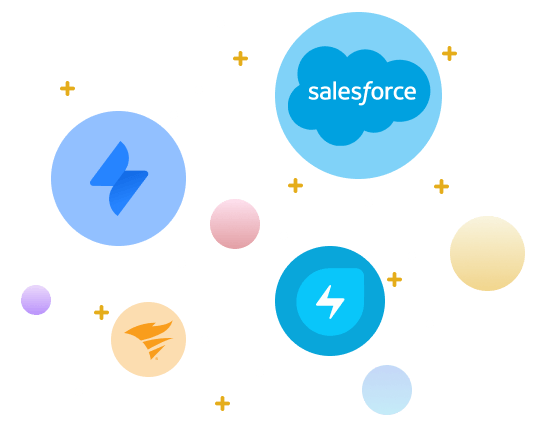Service Desks
What is the service desk software?
To make people use the product or service, businesses across many industries employ service desk software to track, manage, analyze internal support requests and operations. These platforms don’t replace customer service teams (IT, HR, and finance,) but help them to perform better – automate the routine tasks and processes, assign and route tickets, collect report on issues, customer satisfaction, and support agent performance.
Contact us
Best service desk software
Service desk software (or IT service desk software) focuses on providing service and places ITSM on the leading position. Currently, many platforms are ITIL-compliant. Due to the ITIL (Information Technology Infrastructure Library) framework, they enable a shared contact point for customers and IT staff where all the requests are made. Since the queries and incidents are collected, you can prevent existing or possible disruptions in service availability and quality.
In comparison to call centers, ticketing systems or help desk platforms, service desk software offers more advanced functionality. If the solution is ITIL-compliant, it delivers a single point where a customer can get a broad range of options to fulfill nearly any IT requirement. Speaking of other benefits of IT service desk software, it is worth to mention the ability to enhance the integration of various business processes and service management ecosystem. So these platforms can handle the incident management, customer queries management, and delivering communication channels for other service purposes along with supporting the change requests, contract maintenance, and software licensing, too.
You can enable the customer support in multiple levels and streamline the processes on
- the front line delivers a quick fix to common issues and repetitive questions and
- the supervisory levels deal with escalated problems.
Like help desk, the service desk platforms can perform prompt customer support via multiple channels – phone, instant messengers, chat, email, and integrated Facebook and Twitter. The software also brings constant monitoring and issue resolving to ensure the steady or even growing customer satisfaction rates. The tickets and its resolutions, customer interaction history (i.e., email, phone calls, other messages received via live chat or IM) can be stored as a reference for support agents and the backbone for developing best practices.
Does your current system no longer offer a competitive advantage? Then check out these IT service desk platforms that have proven their efficiency. The position is a list is random and doesn’t show any preferences to the IT service desk vendors.
Benefits and drawbacks of service desk software
Benefits
Spending a lot of time refining the quality of support service is more accessible with the modern service desk software. The customers’ issues are communicated via multiple channels, routine tasks automated, data collected and analyzed whereas the physical service landscape is also included. All those pieces deliver accurate organization and achieving the maximum efficiency. In point of fact, IT practices are enhanced, and you get a handful of advantages.
Disadvantages
Contrary to popular belief, IT desk software is not a life-saver. And if you select the most expensive or the most praised in the reviews, it may turn out the opposite for you. This can cost you new and existing customers. This kind of software performs excellent if it is chosen correctly. On the other hand, you may have internal issues with the long learning curve, remote team, lack of support reps’ expertise, and the like. To be ready for the “unforeseen” challenges, prepare in advance for choosing the service desk platform.
-
Varied issue intake
With multiple communication points, your brand is open and can provide quality and fast queries management. The shared inbox and automated assigning and routing help the support team to focus on the urgent and complex tasks.
-
Enhanced multitasking
No doubt that automation is the secret sauce of support service efficiency. It handles nearly any volume of communication queries, managers workloads, assigns and routes tickets and calls. IT service desk software saves time on the prioritizing the issues and flexible enough to align with any workflow so the support reps with getting notifications and tickets correspondently to set rules.
-
Customization
Every business has a specific strategy, goals, and targets to achieve, so that requires flexibility from the service desk software. The customization option in many platforms allows not only adding extra fields to tickets or customer profile, but also change the workflows, internal search, and automation setting.
-
Customer Management
Apart from a shared inbox, the self-service portal, your IT service desk delivers a unified customer base. That’s a life-saver for support reps who get all the information about a client, their orders, previous issues and many more details (if they were added into the system) right at their fingertips. Knowing customer’s troubles wins loyalty and enhances issue resolution
-
Automated Prioritization
Many of service desk software provides options to automate and categorize issues based on the difficulty or urgency. Other tools that distribute tasks among the support reps can be set to show the high-risk and urgent tickets at first place. So the team will be routed to the most important issues without any manual pre-selection.
-
Ticket Routing
The automation delivers many enhancements and reduces the routine in overall support service performance, and support agents too. The ticket auto-assignment and routing take the place of must-have option in the service desk software toolbox. That allows setting specific rules for certain issue types so the selected employee or team will get the task to handle once the customer sends the request.
-
Advanced Search
The notes, tags, and mentions are helpful in ticket classification and cooperation with team members. But they are also enhance searching inside the service desk system base for the precedents or similar cases.
-
Define the Reason of Adoption
The service desk systems help businesses to handle B2B customer support and deal with internal technical issues. Once you define what the goals for IT service desk adoption are, you will know where to start with system settings and employee training.
-
Measurable and Achievable Goals
Focus on business needs before implementing a solution is a wise move; however, if you want to improve the experience of customers and employees – set achievable goals. As a rule, the targets are twofold: financial and service improvements. Ensure you have defined them clearly and look for an IT service desk with a suitable feature set.
-
When Switch to SaaS Service Desk
This point relates to businesses that move from an on-premise solution to a cloud one. The ability to address customer’s pain points on the spot with a new IT service platform is attractive. Thus, you should analyze the current infrastructure and business processes that will be aligned with the service desk software. Once the platform is chosen, take a look at the vendor’s SLA to understand what services, security, and support you can get. That will save time and efforts in the future.
Benefits and drawbacks of service desk software
Benefits
Spending a lot of time refining the quality of support service is more accessible with the modern service desk software. The customers’ issues are communicated via multiple channels, routine tasks automated, data collected and analyzed whereas the physical service landscape is also included. All those pieces deliver accurate organization and achieving the maximum efficiency. In point of fact, IT practices are enhanced, and you get a handful of advantages.
-
Varied issue intake
With multiple communication points, your brand is open and can provide quality and fast queries management. The shared inbox and automated assigning and routing help the support team to focus on the urgent and complex tasks.
-
Enhanced multitasking
No doubt that automation is the secret sauce of support service efficiency. It handles nearly any volume of communication queries, managers workloads, assigns and routes tickets and calls. IT service desk software saves time on the prioritizing the issues and flexible enough to align with any workflow so the support reps with getting notifications and tickets correspondently to set rules.
-
Customization
Every business has a specific strategy, goals, and targets to achieve, so that requires flexibility from the service desk software. The customization option in many platforms allows not only adding extra fields to tickets or customer profile, but also change the workflows, internal search, and automation setting.
-
Customer Management
Apart from a shared inbox, the self-service portal, your IT service desk delivers a unified customer base. That’s a life-saver for support reps who get all the information about a client, their orders, previous issues and many more details (if they were added into the system) right at their fingertips. Knowing customer’s troubles wins loyalty and enhances issue resolution
-
Automated Prioritization
Many of service desk software provides options to automate and categorize issues based on the difficulty or urgency. Other tools that distribute tasks among the support reps can be set to show the high-risk and urgent tickets at first place. So the team will be routed to the most important issues without any manual pre-selection.
-
Ticket Routing
The automation delivers many enhancements and reduces the routine in overall support service performance, and support agents too. The ticket auto-assignment and routing take the place of must-have option in the service desk software toolbox. That allows setting specific rules for certain issue types so the selected employee or team will get the task to handle once the customer sends the request.
-
Advanced Search
The notes, tags, and mentions are helpful in ticket classification and cooperation with team members. But they are also enhance searching inside the service desk system base for the precedents or similar cases.
Disadvantages
Contrary to popular belief, IT desk software is not a life-saver. And if you select the most expensive or the most praised in the reviews, it may turn out the opposite for you. This can cost you new and existing customers. This kind of software performs excellent if it is chosen correctly. On the other hand, you may have internal issues with the long learning curve, remote team, lack of support reps’ expertise, and the like. To be ready for the “unforeseen” challenges, prepare in advance for choosing the service desk platform.
-
Define the Reason of Adoption
The service desk systems help businesses to handle B2B customer support and deal with internal technical issues. Once you define what the goals for IT service desk adoption are, you will know where to start with system settings and employee training.
-
Measurable and Achievable Goals
Focus on business needs before implementing a solution is a wise move; however, if you want to improve the experience of customers and employees – set achievable goals. As a rule, the targets are twofold: financial and service improvements. Ensure you have defined them clearly and look for an IT service desk with a suitable feature set.
-
When Switch to SaaS Service Desk
This point relates to businesses that move from an on-premise solution to a cloud one. The ability to address customer’s pain points on the spot with a new IT service platform is attractive. Thus, you should analyze the current infrastructure and business processes that will be aligned with the service desk software. Once the platform is chosen, take a look at the vendor’s SLA to understand what services, security, and support you can get. That will save time and efforts in the future.
What is the difference between the help desk and service desk software?
- the kind of product or service you offer
- the volume of support you provide
- the audience you serve
- the way you deliver the issue or its resolution
To meet customer expectations, companies adopt the practices of support service while others make it more exclusive and extensive. Don’t buy in that “help desk” is an old term and “service desk” is a fresh and hyped one. But a few details will help you to distinguish which term is applicable to your support desk.
Help Desk
With the expense of the available features, a help desk can be both: a platform for support service and a part of IT service desk software.
Service Desk
Many of the help desk platforms provide tiered functionality – a ticketing system as a core while live chat, a knowledge base, a call center, and others as the add-ons. It’s important to note that service desk software collects these features within a single platform.
Service desk customers: who can use it?
To be more specific, the platforms help small companies to reduce support team workload and automate the routine tasks, as well as deliver self-service portals to customers. The mid-sized businesses rely heavily on multi-channel supports, automation, analytics, and third-party app integrations. Large enterprises take advantage of the multitasking, various functionality, developer sandbox, and extended analytics and other fancy options for predicting and improving customer satisfaction rates.
A brief description of the service desk types
To have a shared understanding of the job to be done, you should define what service desk software will address your requirements. There are four types of service desk platforms:
Issue tracking systems
Issue tracking systems (aka ITS) are the most spread type presented in the market. This software works as a ticketing system that tracks the issue progress up to the resolution. Under the “issue” can be meant customer question, feature request, bug report or any other development inquiry. Each issue has a couple of parameters that identify its urgency and priority, the way the problem experienced by a customer, and other relevant comments. The system can create tickets from customer inquiries, assign them to a team or a specific employee, track the progress and time spent on the ticket. At the same time, it ensures that the process adheres to the internal workflows, and collect information for further analysis and reporting.The service desk software of this type is SysAid, Pivotal Tracker, Jira, Kayako SupportSuite, Microsoft Dynamics CRM, Plain Ticket, Zoho BugTracker, and others.

Remote support software
- attended (on-demand) support happens when a customer wants a quick fix in a timely manner. Usually, it means that there has appeared a problem while using an app or service. The support agent connects to a customer’s device and resolves the issue without any pre-installation.
- unattended support works in the same way as the attended one, but the support rep can access a customer’s device even if the customer is absent. The support employee sends the streamer app to be installed and get remote access. That allows the support team to updates, maintain, and update all devices and keep them in proper-managed status.
Here are a few platforms of this service desk software enlisted: ConnectWise Control, Zoho Assist, Bomgar Remote Support, TeamViewer, ConnectWise Automate, Zendesk, AnyDesk, Atera, and others.

Password self-service platforms
Password self-service platforms allow support reps to manage passwords and reset them automatedly. This kind of solutions is appreciated by the companies that receive the repetitive request on the password reset. How does it work? The customer sets off a password reset from browser or login, and then the system checks the identity by some factor to the forgotten or disabled password. And if everything is correct, the customer can reset a password and unlock the account. Password self-service platforms deliver a higher security level, advanced identity management, single sign-on, password management, document management what brings win-win deal for companies and customers.Here are a few platforms of this service desk software enlisted: Oracle Identity Management, CloudCodes, OneLogin, Zoho Vault, Salesforce Platform, Trulioo, and others.

Asset tracking applications
Asset tracking applications collect and manage information about the status and location of the company’s assets and minimize the equipment loss. Mostly, they use scanners to detect barcodes for item verification. Alternatively, you can add data on assets manually into the register. Unlike inventory tracking, asset tracking manages information about the items that the company owns as well as the location, ownership, status, quality, associated documents and the like.Among the service desk software of this type are Salesforce Service Cloud, Asset Track, WebCheckout, ServiceDesk Plus, ServiceNow Asset Management, SysAid, Freshservice, Samanage.

Functionality: core and extended
- Ticket, service request, and issue management
- Live chat
- Call Center
- Community forum
- A knowledge base
- Shared inbox
- Notifications
- SLA management
- Analytics and reporting
- Logs and permissions
- Integration capabilities
- Mobile apps
- Ticket and call routing
- Call management
- Customer management
- Document management
- Custom fields and forms
- Project management
- Budget and expense tracking
- Multi-language support
- CSAT surveys
How to compare service desk software?
The offer of service desk software is slightly tricky due to the different prices and features. To kick things off, define the key elements you need to frame business goals and fix the problems. Ultimately, during the choice, you should pay attention to such aspects as- Ticket, asset, and change management
- Support agent productivity tools
- Automation and customizable workflows
- Integration capabilities
- Subscription costs
Trials, demos, and costs: how to plan the budget?
To provide better compliance with customers needs, the service desk software vendors offer a few price tiers with different functionality sets. The subscriptions can be paid monthly or annually, as a rule, the last one is cheaper. Pay attention to the contract and what services, support options, and other conditions it has. Some vendors suggest a freemium plan along with the paid ones. In case, you have a small team up to 3 or 5 employees, you may find a freemium quite suitable.Another option to grab is the free trials. There are available 7-days, 14-days or 30-days trials of a particular price tier. The vendors tend to provide an extensive feature set in the trial. If you have defined the functionality you want to try in action, you can ask a demo from the vendor. This way will help you to decide whether this software worth your investments.



